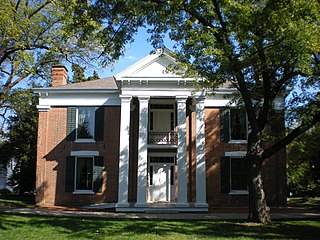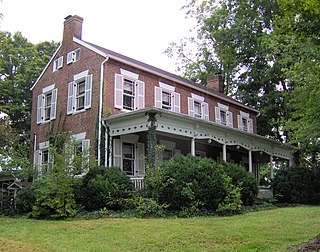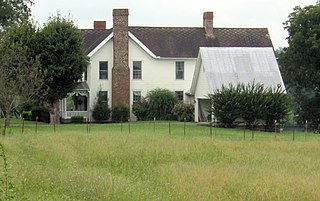
Stratford Hall is a historic house museum near Lerty in Westmoreland County, Virginia. It was the plantation house of four generations of the Lee family of Virginia. Stratford Hall is the boyhood home of two signers of the Declaration of Independence, Richard Henry Lee (1732–1794), and Francis Lightfoot Lee (1734–1797). Stratford Hall is also the birthplace of Robert Edward Lee (1807–1870), who served as General-in-Chief of the Confederate States Army during the American Civil War (1861–1865). The Stratford Hall estate was designated a National Historic Landmark in 1960, under the care of the National Park Service in the U.S. Department of the Interior.

The Zachary Taylor House, also known as Springfield, was the boyhood home of the twelfth President of the United States, Zachary Taylor. Located in what is now a residential area of Louisville, Kentucky, Taylor lived there from 1795 to 1808, held his marriage there in 1810, and returned there periodically the rest of his life.

Lower Brandon Plantation is located on the south shore of the James River in present-day Prince George County, Virginia.

Oatlands Historic House and Gardens is an estate located in Leesburg, Virginia. Oatlands is operated by the National Trust for Historic Preservation and is listed on the National Register of Historic Places as a National Historic Landmark. The Oatlands property is composed of the main mansion and 415 acres of farmland and gardens. The house is judged one of the finest Federal period country estate houses in the nation.

The John Wornall House Museum is a historic house museum in Kansas City, Missouri. The museum, located at 6115 Wornall Road in the Brookside area of Kansas City, is furnished to represent the daily life of a prosperous, pre-Civil War family.

Cedar Crest, also known as Cedar Crest Farms, is a Greek Revival plantation house located near Faunsdale, Alabama. It was built for Kimbrough Cassels Dubose in 1850 by Albert Prince, a slave. Dubose, born in Darlington District, South Carolina was educated at the preparatory school of Prof. Stafford who later was of the faculty of the University of Alabama. His wife was Miss Elizabeth Boykin Witherspoon also of Darlington District, South Carolina, and they had seven sons and four daughters: John Witherspoon, James Henry, Jr., Eugene, Nicholas William, Francis Marion, Lemuel Benton and Edwin Dargan-the daughters Louisa, Rosalie, Augusta and Adele. The house is one-and-a-half stories with side gables, but has been simplified. It originally had side wings, with adjoining porches across the front. These were removed in 1939, leaving the small central front portico. Another historic plantation house, Altwood, was moved from a nearby location to the Cedar Crest grounds in 1988. The house was added to the National Register of Historic Places on August 5, 1993 as a part of the Plantation Houses of the Alabama Canebrake and Their Associated Outbuildings Multiple Property Submission.

Wheatlands is an antebellum plantation in Sevier County, in the U.S. state of Tennessee. The plantation's surviving structures— which include the plantation house, a storage shed, and smokehouse— have been placed on the National Register of Historic Places. The plantation house has been called "the best example of a Federal-style building remaining in Sevier County."

Brabson's Ferry Plantation is a Pioneer Century farm and former antebellum plantation near the U.S. city of Sevierville, Tennessee. Located at what was once a strategic crossing of the French Broad River, by 1860 the plantation had become one of the largest in East Tennessee, and one of the few in the region that rivalled the large plantations of the Deep South in size and influence. The farm remains in operation, and several of its historic structures— including two plantation houses and an 18th-century plank house— have been added to the National Register of Historic Places.
Finney House may refer to:

The Banfill Tavern, also known as the Locke House, is a historic building in Fridley, Minnesota, United States. It was built in 1847 on the east bank of the Mississippi River and has served variously as an inn, a logging camp office, a private home, a dairy farm, a post office, and a summer home. It is now owned by Anoka County and houses the non-profit Banfill-Locke Center for the Arts. The building stands within Manomin County Park, and the art center is a partner site of the Mississippi National River and Recreation Area.

Perciphull Campbell House is a historic home located near Union Grove in Iredell County, North Carolina. The house was built about 1820 by Perciphull Campbell and is a two-story, frame I-house dwelling. It has a gable roof, stone foundation, and exterior chimneys with stuccoed brick stacks. Also on the property is the contributing smokehouse.

Beech Grove is a historic mansion in Nashville, Tennessee, USA. Built as a log house circa 1850, it was a Southern plantation with African slaves in the Antebellum era. In the 1910s, it became a livestock farm.

Ashcrest Farm is a historic mansion in Hendersonville, Tennessee, U.S.. Designed in the Classical Revival architectural style, it was built by slaves before the American Civil War and black laborers after the war. The land has been owned by the same family since 1810. Today, it is a horse farm.

The Mansfield Cheatham House is a historic mansion in Springfield, Tennessee, U.S..

The Hall-Harding-McCampbell House is a historic mansion in Nashville, Tennessee, U.S..
Dozier Farm, also known as Cliffview Farm, is a historic mansion in Nashville, Tennessee, U.S..

Ewing Farm is a historic farmhouse three miles away from Lewisburg, Tennessee, US.

The Logan Henderson Farm, also known as Farmington, is a historic farm house in Murfreesboro, Tennessee, U.S.. Built as a slave plantation in the Antebellum South, it later became a dairy and cattle farm. It is now a horse farm.

Wessyngton is a historic mansion on a former tobacco plantation in Cedar Hill, Tennessee, U.S. It is listed on the National Register of Historic Places.

The Walton-Wiggins Farm is a historic farmhouse in Springfield, Tennessee, U.S..

















